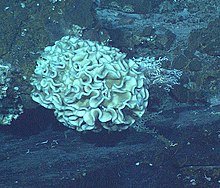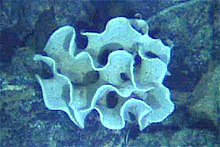Xenophyophorea
| Xenophyophorea | |
|---|---|

| |
| Image of a deep sea xenophyophore | |

| |
| Xenophyophore at the Galapagos Rift | |
| Scientific classification | |
| Domain: | Eukaryota |
| Clade: | Diaphoretickes |
| Clade: | SAR |
| Phylum: | Retaria |
| Subphylum: | Foraminifera |
| Class: | Monothalamea |
| Clade: | Xenophyophorea Schulze, 1904 |
| Orders and subtaxa incertae sedis[2] | |
| |
Xenophyophorea
They were first described by
Naming and classification
The name Xenophyophora means "bearer of foreign bodies", from the
A 2013 molecular study using
Historically xenophyophores have been divided into the agglutinated Psamminida and the flexible, proteinaceous Stannomida.[16] However, cladistic analyses based on molecular data have suggested a high amount of homoplasy, and that the division between psamminids and stannomids is not well supported.[15]
Anatomy

Xenophyophores are unicellular, but have many nuclei. Many form delicate and elaborate agglutinated tests—shells often made of calcium carbonate (CaCO3) and other foreign mineral particles glued together with organic cements[17]—that range from a few millimetres to 20 centimetres across. The softness and structure of tests varies from soft and lumpy shapes to fans and complex structures.
Some xenophyophores—notably Psammina—have compartmentalized tests consisting of multiple chambers.[16]
Species of this group are morphologically variable, but the general structural pattern includes a test enclosing a branching system of organic tubules together with masses of waste material.
A number of unique terms are used to refer to anatomical aspects of the group:
- Individual waste pellets are referred to as stercomes or stercomata; pellets that are bundled together in long strings are referred to as stercomares. Stercomares also include small, yellow-red spherical bodies known as xanthosomes.
- Xenophyophores also commonly have abundant crystals of barite called granellae within their cytoplasm. This is not to be confused with the granellare, which refers to the plasma body and its tube.
- Linellae are long (several mm in length), threadlike structures found outside of the granellare in some xenophyophores (genera traditionally grouped together as "stannomida"); they are flexible and form part of the test.
- Xenophyae, for which the group is named, are the agglutinated particles from which the test is constructed. They vary by species; they can contain sediment particles, sponge spicules, radiolarian tests, and even the tests of smaller foraminifera.[4]
The protoplasm of xenophyophores contributes less than 1% of the total mass of the organism.[18]
They select certain minerals and elements from their environment that are included in its tests and cytoplasm, or concentrated in excretions. The selected minerals vary with species, but often include barite, lead and uranium.[19] The granellare of Shinkaiya have been found to contain high concentrations of mercury.[20]
Studies have found unusually high concentrations of radioactive nuclides in xenophyophores; this was first reported in Occultammina but has since been found to be true of many other xenophyophore species from different parts of the ocean.[21][22]
Growth and reproduction
Very little is known about xenophyophore reproduction. It is assumed that an alternation of generations takes place, as in other foraminifera; however, this has not been confirmed.
Gametes form in a specialised part of the granellare that may look like swollen side-branch (in Psammetta) or a stalked bulb (in Cerelasma). Gametes are reportedly about 20 µm in diameter, with two flagella; after this, an amoeba-like stage seems to be present. It is also possible that the amoeboid stage represents amoeboid gametes, found in other foraminifera. These amoeboid structures are also sometimes found inside the granellare. Juveniles have occasionally been found in association with adults; in Psametta they are horseshoe-shaped and already covered in xenophyae.
The location of the initial plasma can sometimes be pointed out in adult xenophyophores. In some species this is denoted by a sharp change in the type of xenophyae; in others, the juvenile is regular and the adult is irregular; still others flip this pattern, so that the juvenile is irregular and the adult is regular.[4]
Growth is episodic; one observational study taking place over a period of eight months saw a three-to-tenfold growth in specimens of Reticulammina labyrinthica. This growth occurred in phases lasting 2–3 days each; each phase was separated by a resting period of approximately two months. These growth phases were approximately synchronous between specimens, but it is unclear if this is biologically or developmentally controlled; some evidence suggests the synchrony may have been due to chance.
Each episode of growth occurred in three phases: first, the base becomes wider and flatter, causing the surface texture to become smoother; then, the original shape of the organism is regained (albeit larger); and finally, the surface texture is rebuilt. The rapid rate of growth observed suggests that xenophyophores may not be as long-lived as previously hypothesised.[23]

Habitat and range
Xenophyophores are an important part of the deep sea-floor, as they have been found in all four major ocean basins.
Xenophyophores have been found between depths of 500 and 10,600 metres. Most are epifaunal (living atop the seabed), but one species (Occultammina profunda), is known to be infaunal; it buries itself up to 6 centimetres (2.4 in) deep into the sediment.[3][4][29]
Xenophyophore densities are highest on soft sediments; however, they may still be found on rocky substrates including basalts, canyon walls, and manganese crusts.[18]
Feeding
The diet and feeding ecology of xenophyophores was long the subject of speculation; the fragile tests and deepwater habitat of the group makes in vivo observation difficult. Early propositions included
A 2021 study that utilised isotopic labeling to examine the question of xenophyophore feeding confirmed rapid uptake of both diatoms and dissolved organic matter in the form of glucose. This study found no evidence to support a bacterial farming function for the test, and instead proposed that it aided to function in the collection of phytodetritus by increasing surface area. These authors argued that xenophyophores fill a major role in ocean-floor biogeochemical cycling.[31]
Fossil record
As of 2017, no positively-identified xenophyophore fossils had been discovered.[15]

It has been suggested that the mysterious
Some researchers have suggested that the enigmatic graphoglyptids, known from the early Cambrian through recent times, could represent the remains of xenophyophores,[37][38] and noted the similarity of the extant xenophyophore Occultammina to the fossil.[39] Supporting this notion is the similar abyssal habitat of living xenophyophores to the inferred habitat of fossil graphoglyptids; however, the large size (up to 0.5m) and regularity of many graphoglyptids as well as the apparent absence of xenophyae in their fossils casts doubt on the possibility.[39] Modern examples of Paleodictyon have been discovered; however, no evidence of tests, stercomares, grannelares, or xenophyophore DNA was found, and the trace may alternately represent a burrow or a glass sponge.[40]
Certain Carboniferous fossils have been suggested to represent the remains of xenophyophores due to the concentration of barium within the fossils as well as supposed morphological similarity; however, the barium content was later determined to be due to diagenetic alteration of the material and the morphology of the specimen instead supported an algal affinity.[41]
Ecology

Local population densities may be as high as 2,000 individuals per 100 square metres (1,100 sq ft), making them dominant organisms in some areas. Xenophyophores have been found to be "
Starfish, monoplacophorans, and molpadiid sea cucumbers have all been observed feeding on xenophyophores; specifically, the monoplacophoran Neopilina galatheae has been proposed as a specialised predator of the group.[18]
Despite this abundance, the relatively low amount of protoplasm per unit of test means that xenophyophores often contribute little to total biomass.[18]
Xenophyophores are difficult to study due to their extreme fragility. Specimens are invariably damaged during sampling, rendering them useless for captive study or
Scientists in the submersible
Different xenophyophore ecomorphs are found in different settings; reticulated or heavily folded genera such as Reticulammina and Syringammina are more common in areas where the substrate is sloped or near canyon walls, while more fan-shaped forms like Stannophyllum are more common in areas with quieter water and/or lower primary productivity.[18]
List of genera
- Syringammina[15]
- Occultammina[15]
- Aschemonella[15]
- Psammina[15]
- Galatheammina[15]
- Semipsammina[15]
- Stannophyllum[15]
- Semipsammina[15]
- Homogammina[15]
- Rhizammina[15]
- Shinkaiya[15]
- Cerelasma[15]
- Spiculammina[15]
- Bizarria[5]
- Tendalia[5]
- Nazareammina[45]
- Cerelpemma[15]
- Maudammina[15]
- Psametta[15]
- Stannoma[15]
- Maudammina[4]
- Cerelpemma?[4]
- Holopsamma[42]
- Abyssalia[46]
- Moanammina[46]
See also
References
- ^ Tendal, O.S. (1972) A MONOGRAPH OF THE XENOPHYOPHORIA (Rhizopodea, Protozoa)
- ^ Hayward, B.W.; Le Coze, F.; Gross, O. (2019). World Foraminifera Database. Monothalamea. Accessed through: World Register of Marine Species at: http://www.marinespecies.org/aphia.php?p=taxdetails&id=744106 on 2019-01-07
- ^ a b MSNBC Staff (22 October 2011). "Giant amoebas discovered in deepest ocean trench". NBC News. Retrieved 2011-10-24.
- ^ a b c d e f g h Tendal, O. S. (1972). A Monograph of the Xenophyophoria (Rhizopodea, Protozoa) (Doctoral dissertation). Danish Science Press.
- ^ ISSN 0024-4082.
- ^ .
- ^ Brady, H.B. (1884). "Report on the Foraminifera. Report on the Scientific Results of the Voyage of H. M. S. Challenger". 9: 1–814.
{{cite journal}}: Cite journal requires|journal=(help) - ^ Haeckel, E. (1889). "Report on the scientific results of the voyage of H. M. S. Challenger during the years 1873–76". Zoology. 32: 1–92.
- ^ Schulze, F. E. (1907). "Die Xenophyophoren, eine besondere Gruppe der Rhizopoden". Wissenschaftliche Ergebnisse der Deutschen Tiefsee-Expedition Auf dem Dampfer 'Validivia' 1898–1899. 11: 1–55.
- ^ Lee, J. J.; Leedale, G. F.; Bradbury, P. (2000). The illustrated guide to the protozoa (2nd ed.). Society of protozoologists. Lawrence, KS: Allen Press.
- S2CID 39906626.
- ISSN 1096-3642.
- .
- ISSN 0377-8398.
- ^ ISSN 0006-3207.
- ^ ISSN 1475-4983.
- ^ London, Postgraduate Unit of Micropalaeontology, University College (2002). "Foraminifera". www.ucl.ac.uk. Retrieved 2018-06-17.
{{cite web}}: CS1 maint: multiple names: authors list (link) - ^ ISBN 978-94-011-2452-2, retrieved 2020-09-30
- .
- PMID 30108286.
- S2CID 4254138.
- S2CID 127121951.
- .
- ^ Levin, L. A.; Gooday, A. J. (1992). Rowe, G. T.; Pariente, V. (eds.). Possible roles for Xenophyophores in dee-sea carbon cycling. In: Deep-Sea Food Chains and the Global Carbon Cycle. The Netherlands: Kluwer Academic. pp. 93–104.
- .
- ^ Tendal, O. S. (1996). "Synoptic checklist and bibliography of the Xenophyophorea (Protista), with a zoogeopgraphical survey of the group" (PDF). Galathea Report. 17: 79–101.
- ^ Tendal, O. S.; Gooday, A. J. (1981). "Xenophyophoria (Rhizopoda, Protozoa) in bottom photographs from the bathyal and abyssal NE Atlantic" (PDF). Oceanologica Acta. 4: 415–422.
- .
- ISSN 0399-1784.
- ISSN 0171-8630.
- ISSN 0967-0637.
- S2CID 128619251.
- PMID 30237355.
- S2CID 85146476.
- S2CID 128952011.
- ISSN 0301-9268.
- ^ Jensen, Soren. "Jensen, S. and Palacios, T. 2006. A peri-Gondwanan cradle for the trace fossil Paleodictyon. In: 22 Jornadas de Paleontologia, Comunicaciones, 132-134".
{{cite journal}}: Cite journal requires|journal=(help) - S2CID 28690086.
- ^ JSTOR 3515076.
- ISSN 0967-0645.
- ISSN 1502-3931.
- ^ .
- PMID 31742677.
- S2CID 86707195.
- ISSN 0967-0637.
- ^ PMID 32585572.
Further reading
- Gubbay, S., Baker, M., Bettn, B., Konnecker, G. (2002). "The offshore directory: Review of a selection of habitats, communities and species of the north-east Atlantic", pp. 74–77.
- NOAA Ocean Explorer. "Windows to the deep exploration: Giants of the protozoa", p. 2.
